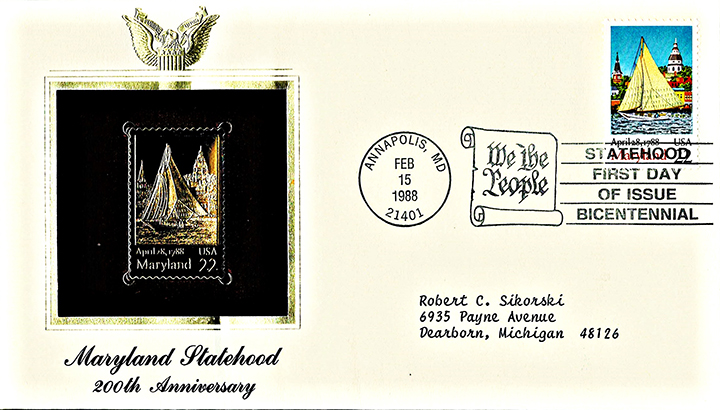
Maryland on Stamps…

Richard D. L. Fulton
On February 15, 1988, the United States Postal Service issued a set of 50 22-cent stamps commemorating when each of the 50 states had achieved statehood, one of which was devoted to Maryland.
Each state’s stamps were featured on First Day of Issue covers (FDCs) when the stamps had been initially made available to the public. FDCs of the Maryland stamp were cancelled in the Annapolis Post Office – Annapolis, of course, being the capitol of the state.
The Maryland stamp featured a skipjack (two-sailed fishing boats used particularly for harvesting oysters) displayed with the Maryland statehouse within the background.
The skipjack was also designated as being the “State Boat” in 1985. The Maryland statehouse is the oldest state capital building that has been in continual legislative use since its establishment and had additionally served as the nation’s capital building from November 26, 1783 to August 13, 1784.
Maryland, initially established as a British colony and province, actually became a state twice… and nearly became a third one.
The First State of Maryland
The first United States of America was established with the passage of the Articles of Confederation. The proposal to unite the then-existing but seceded British colonies into a united form of governance under the auspices of a central (federal) government had been approved by the Continental Congress on November 15, 1777, before the American Revolution had even concluded.
Subsequently, the congressionally approved Articles of Confederation were ratified into law by the 13 autonomous, ex-colonies in 1781, thereby resulting in each of the former colonies becoming the first states of America.
Naturally, Maryland was among the newly founded states. Under the Articles of Confederation, Maryland, and her sister states, thrived under the limited power of the federal government… for a time, just shy of a decade.
In the wake of the ratification of the Articles of Confederation, there were dissenters seeking to “overthrow” the newly formed United States, and create a new, second United States of America, headed up by a more powerful form of central (federal) government.
The Second State of Maryland
The proposal to secede from the (first) United States and replace it with a second version was not a thoroughly popular idea.
In fact, the idea was so unpopular from the outset that the soon-to-be founding fathers, under the guise of holding a Constitutional Convention with the stated purpose to revise the Articles of Confederation, hid themselves away in the Pennsylvania State House, locking the door and posting guards, with the intent to dissolve the Articles of Confederation, and replace it with a new constitution – which, basically they had feared, could constitute an act of insurrection.
When the proposed new constitution was fully disclosed to the general population, and the road to ratification had been initiated, the “founders” managed to avoid having the new constitution ratified by each of the state legislatures, knowing that most would be reluctant to authorize surrendering their more lenient individual autonomy, as had been established under the Articles of Confederation, to founding a more heavy-handed form of central governance.
As was noted in The Constitution: How Did it Happen? (National Archives),“The Anti-Federalists fought hard against the Constitution because it created a powerful central government that reminded them of the one they had just overthrown… The ratification campaign was a nail-biter.”
Nevertheless, the effort succeeded, and Maryland officially became a state (again) on April 28, 1788 (although the newly ratified Constitution did not take effect until March 9, 1789), when Maryland’s appointed representatives cast their vote to ratify the United States Constitution. Maryland was the seventh state of the 13 states to do so.
The Confederate State of Maryland?
But a subsequent war, which erupted between the states in 1861, saw Marylanders launching an effort to a new statehood, this time under the constitution of the Confederate States of America.
However, “Confederate Maryland” will be further addressed in the next column, Maryland on Stamps… Antietam, in the September issue of the Catoctin Banner).
First Day of Issue Cover of Maryland’s Bicentennial stamp with 22K gold version insert.
